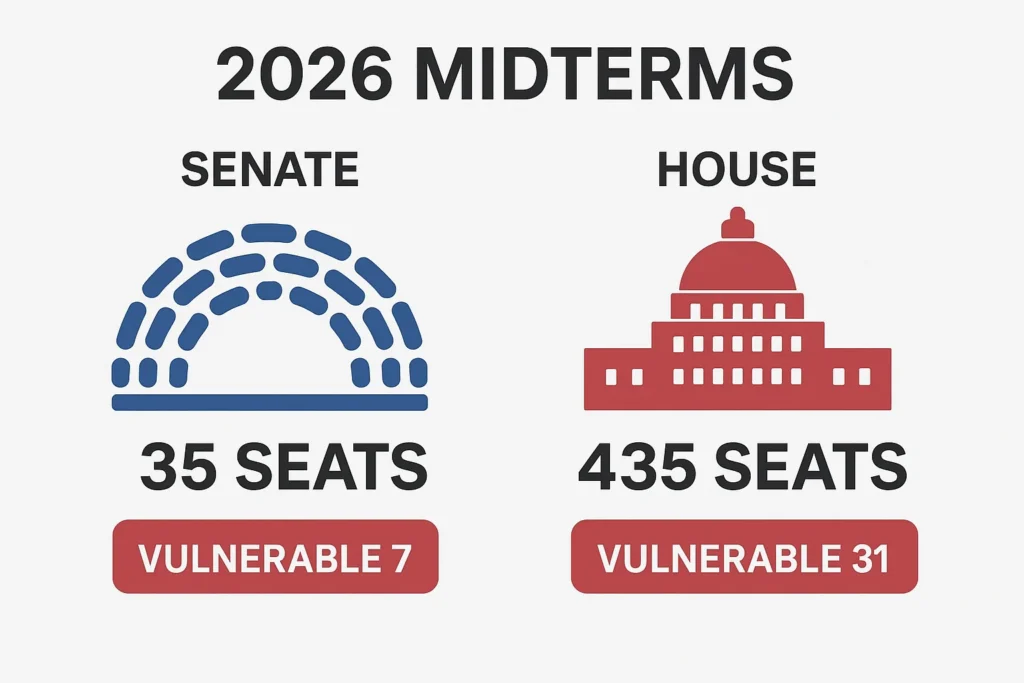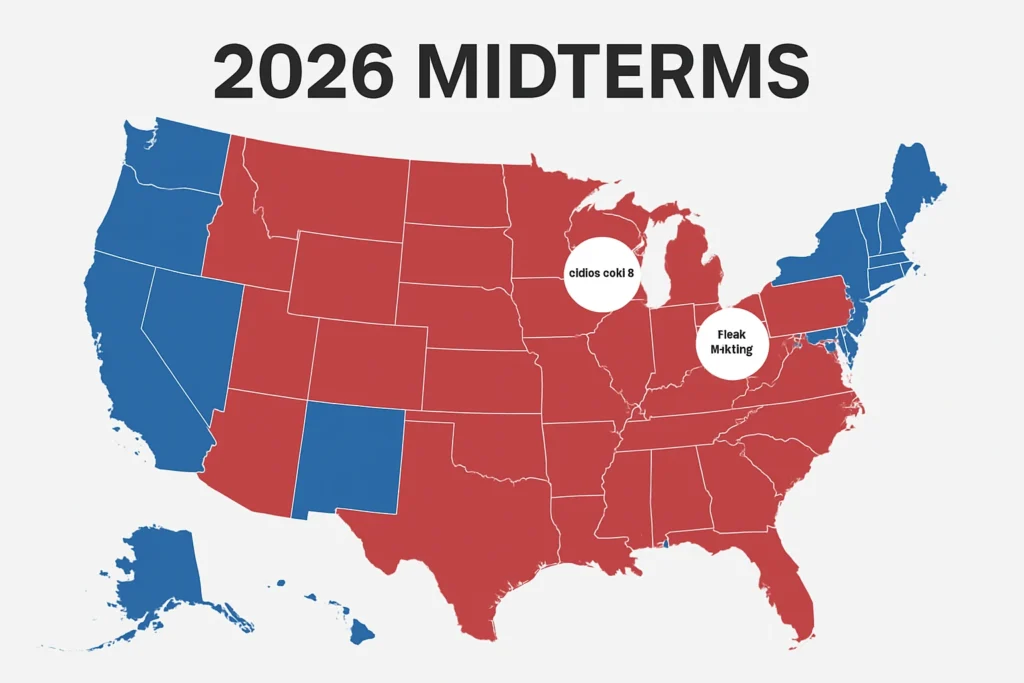The United States Midterm Election 2026, scheduled for November 3, 2026, will determine the political balance of power in Washington and across many states. With all 435 U.S. House seats and 35 of the 100 U.S. Senate seats up for grabs, as well as numerous gubernatorial, state, and local elections, the results will shape policy for the remaining term of the current presidency and set the stage for the 2028 presidential race.
As of October 2025, both major parties are already laying groundwork: redistricting legal fights are underway, debates over voting methods are intensifying, and key issues like healthcare, inflation, election oversight, and voting rights are rising in public importance. This article provides a comprehensive look at what’s known, what’s happening behind the scenes, the main battlegrounds, and what voters should watch as 2026 approaches.
What Exactly Are Midterm Elections?
Midterm elections happen halfway through a presidential term. Federal offices contested include:
- U.S. House of Representatives: All 435 seats are up for election.
- U.S. Senate: 35 seats Class 2 seats and any special elections.
- Statewide Elections: Many states will vote for governors, secretaries of state, state legislatures, and ballot measures.
Why the midterms matter:
- They determine which party controls Congress, influencing what legislation (or lack thereof) can pass.
- They are often seen as a referendum on the sitting president’s performance.
- They shape the political environment ahead of the 2028 presidential election.
READ MORE: Is the U.S Government Shut Down
Current Political Landscape (October 2025)
Redistricting & Legal Battles
One of the most important early developments is in redistricting. As states redraw congressional districts following the 2020 Census, some maps are being challenged in court:
- In Texas, a federal court case in El Paso argues that the state’s newly redrawn congressional map violates the Voting Rights Act, particularly by diluting the influence of Black and Hispanic voters. The new map is expected to increase Republican-held seats from 25 to 30.
- Many states will see similar fights, as district lines often determine which party has an advantage before campaigns even begin.
Voting Methods & Election Rules
Changes in how Americans vote are becoming central issues:
- Mail-in ballots, electronic voting machines, and absentee voting are under scrutiny. President Donald Trump has vowed to end the use of mail-in ballots and electronic voting machines before the 2026 midterms, arguing they are insecure. Legal experts warn that many such changes may face constitutional challenges because states regulate election procedures.
- Control over secretaries of state positions is seen as strategic because they oversee election rules, certification, and in some cases redistricting. Groups aligned with the Democratic Party intend to spend heavily in key state elections to influence oversight of the election process.
Key Party Strategies
- Republicans are focusing on leveraging their current majorities. With control of both the U.S. Senate (53–47) and House (narrow majority) as of late 2025, GOP efforts include pushing redistricting in favorable states and potentially reshaping voter access laws.
- Democrats are zeroing in on healthcare and government services issues, hoping to make the party in power for whatever shortcomings in these areas. The issue of expanding subsidies under the Affordable Care Act is emerging as a focal point for Democratic messaging.

What’s at Stake: Key Races & Seats
Senate
Out of the 35 Senate seats in 2026:
- Democrats are defending several seats in states that Trump won in recent elections.
- Republicans, meanwhile, have more seats to defend in states that are competitive or growing more purple due to demographic changes.
Notable races include:
- New Mexico: Incumbent Democrat Ben Ray Luján is up for reelection. The state is regarded as safely Democratic but could become competitive depending on turnout and broader trends.
- Several retirements and primary challenges will make some seats more unpredictable. Candidates yet to declare in many places make it difficult to fully map the landscape.
READ MORE: How Many Days Left for Trump Presidency?
House of Representatives
All 435 seats are contested in 2026. Vulnerable incumbents, especially in swing districts or those that voted for Trump, are targets for both parties. Redistricting in states like Texas may shift the partisan balance of several districts.
State & Local Elections
- Governorships: Around 39 gubernatorial elections are expected concurrent with the midterms. These positions are influential for state policy and often carry momentum into presidential election cycles.
- Secretaries of State: 26 states have secretaries of state up for election. Control of these offices is crucial for election laws, certification, and administration.
Major Issues Likely to Shape Voter Decision
Here are some of the topics already showing signs of becoming major battleground issues:
- Healthcare & Insurance Costs
Democratic messaging is emphasizing expanding access to affordable healthcare, particularly in light of high insurance premiums and gaps in coverage. - Economic Conditions: Inflation, Wages, Cost-of-Living
Voters often judge incumbents by how they feel economically. Inflation, housing costs, and job security will be central. - Voting Rights & Election Integrity
With debates over mail-in ballots, electronic voting machines, and redistricting, questions about who is allowed to vote, and how, are being politicized. - Abortion, Social Issues & Civil Liberties
Since the 2022 Supreme Court decision eliminating federal abortion protections, state policies and court rulings continue to come up in many races. - Immigration & Border Security
These remain high-visibility issues partly due to national pressure in GOP messaging, partly from localized concerns. - Climate Change & Energy
In swing states where clean energy affects jobs and infrastructure, climate policy will be a more visible issue than in previous midterms. - Election Oversight & Trust in Institutions
Because secretaries of state and local election boards are in play, voter trust (and distrust) in processes will shape turnout.
Historical Trends & What They Predict
To understand what might happen in 2026, it helps to look back:
- Midterms traditionally favor the party not in the White House. Historically, the president’s party often loses seats in Congress during midterms.
- Voter turnout in midterms is typically lower than in presidential years, though already news reports suggest both parties are trying new ways (voter education campaigns, get-out-the-vote efforts) to boost turnout.
- Economic performance has a strong, though not always decisive, effect on midterm outcomes. But increasingly, other factors like social issues, candidate quality, and mobilization of minority voters are just as important.
Key Battleground States & Races
While the national map is wide, certain states will be especially important:
- Texas: As noted, the redistricting case could shift multiple U.S. House seats toward Republicans, depending on how courts rule.
- Georgia: With Brian Kemp opting not to challenge Jon Ossoff for Senate, the Republicans will need a strong candidate to flip or defend the seat.
- Michigan: The Senate seat vacated by Gary Peters has already drawn attention. Mallory McMorrow has declared a Senate campaign, raising the stakes in a traditionally swing state.
- Other states to watch: Arizona, North Carolina, Ohio, Pennsylvania, Nevada historically bellwethers and swing states where small margins could decide outcomes.
READ MORE: How to Register to Vote in 2026
What to Watch in 2025-Early 2026
Here are events and developments that could shift the dynamics significantly:
- Court rulings on redistricting maps in key states (Texas is already in court). The outcomes could reshape House maps before candidates are finalized.
- Legislation or executive action concerning voting methods (mail-in ballots, voting machine regulation). Legal challenges could accelerate in states where changes are made.
- Fundraising and candidate recruitment. Party resources committed early can give advantages particularly in states with high cost of media.
- State-level office races (secretaries of state, attorney generals) that set policy and legal oversight for elections.
- National polling on key issues: economy, healthcare, inflation. Also polling on President’s approval rating, which historically bears heavily on midterm outcomes.
Potential Scenarios & Implications
Depending on how things go, here are plausible outcomes and what they would mean:
| Scenario | What Happens | Implications |
| Republican gains in House & Senate | Republicans widen control or maintain with greater margin. | Likely gridlock in Congress; stronger push for conservative policy, changes in federal oversight; affects 2028 positioning. |
| Democratic retention of Senate or narrow gains | Senate remains competitive; House may flip or remain narrow control. | Democrats push back on major GOP initiatives; ongoing legal fights; strong emphasis on election access. |
| Split Congress (House GOP, Senate Democrat) | More checks and balances; more centrality of judicial and legislative compromise. | Legislation difficult; oversight and investigations increase; moderate or regional issues gain prominence. |
| Low turnout among key demographics | Minority voters, youth, independents underperform. | GOP may benefit; policies less likely to reflect diverse interests. |
How Voters Can Prepare
- Know your registration deadlines: States have different deadlines for registration, early voting, and absentee ballots.
- Stay informed on local races: Many important decisions (school boards, state legislatures) are made at local levels, which affect daily life.
- Check your district maps: Redistricting may have changed your district. Know who your congressional and state representatives are.
- Watch for polling changes and legal rulings: Keep tabs on court decisions that can affect how votes are counted or ballots accepted.
READ MORE: What Analysts Expect for 2026 Elections
Frequently Asked Questions (FAQ)
When is the 2026 U.S. midterm election?
Tuesday, November 3, 2026 across all states.
Why are midterm elections important for the parties?
They determine not just control of Congress, but also set the tone for upcoming national policy, including budgeting, oversight, and preparation for the presidential election.
What is redistricting, and why is it a big deal in 2026?
Redistricting is the redraw of electoral district maps (after census data). It can affect which party has advantage in certain districts. Legal battles over maps in states like Texas may alter seat distributions.
Could changes in voting methods influence the outcome?
Yes. Changes to mail-in ballots, absentee voting, and voting machines are already under discussion, and could be litigated. Such changes often impact turnout and which demographics are most likely to vote
Conclusion
The 2026 U.S. midterm elections are shaping up to be one of the most consequential in recent memory. With redistricting lawsuits, changing voting methods, heated debates over healthcare and economic policy, and every seat in the House plus many in the Senate at play, outcomes will have long-term implications for both domestic and foreign policy.
READ MORE: Iowa Senate Race 2026
For voters, staying informed on local laws, candidates, ballot procedures, and updates is more important than ever. As campaigns unfold, key factors like turnout, polling, and court rulings will likely determine not just who wins, but how effectively they can govern.

